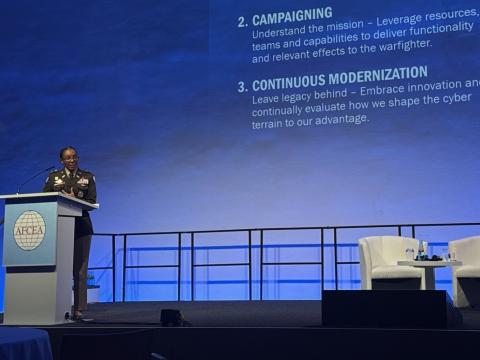In Space, NATO Opts To Rent, Not Own
NATO is transitioning its satellite communications infrastructure from an ownership- and capability-based “bent pipe” arrangement to a more fluid, service-led approach. The challenge for the alliance now is in making plans and provisions for that new capability, which aims at providing a guaranteed ability to obtain the required services to meet collaborative communications needs in space and on the ground.
The alliance’s satellite communications (SATCOM) effort is “pretty diverse and radically different from anything that NATO has previously established to undertake,” says Malcolm Green, chief of Capability Area Team (CAT) 9 National Information Infrastructure (NII) Communication Infrastructure Services, NATO Consultation, Command and Control Agency (NC3A).
“NATO SATCOM will certainly be handicapped if interoperability with national systems is not key to the design of how we go forward,” Green says. Currently, 42 nations are contributing to the International Security Assistance Force (ISAF) mission, a factor reinforcing the need for federating NATO and national capabilities. “The more assets and suppliers that are involved in delivering the capability, the more complex the problems become and the more complex the interoperability and the need for standardization. The final challenge is shifting from today’s paradigm of managing SATCOM as managing circuits into managing services,” Green adds.
Interoperability standardization agreements (STANAGs) exist for nations to adopt anti-jamming waveforms and interoperate with NATO anti-jamming modems, but these STANAGs are not implemented widely. While ultrahigh frequency (UHF) SATCOM interoperability between nations is governed by STANAGs, this is not yet the case with broadband, mobile SATCOM. This had led to the establishment of individual national, closed networks, essentially requiring nations to share modems with other NATO partners.
A major challenge for NATO is being able to cope with fast deployability and mobility requirements, picking up a headquarters or a large command group and throwing them forward, establishing the forward operating position and giving them communications—including the provision of communications in transit and mobility once they are in theater.
“The ways we are exploiting NATO SATCOM Post 2000 [program] today were never comprehended when those plans were put together, yet it is still viable,” Green explains, outlining how legacy systems are being used in the current dialogue. “Plans have to be flexible, they have to anticipate changing paradigms, shortening the reaction times involved, cutting down the lines required to provide and provision the ground segment and space segment in support of the emerging theater of operations.”
One approach is to work with nations to influence their programs to ensure alignment with future requirements. “We can do that in two ways,” Green says. “We can either join those programs early on, defining our needs, and piggyback those with the national program, which means that we in NATO must make our contribution in investment terms with the nations. Or we can sit back more passively and say that we anticipate that the national programs will have capacity that we can exploit sometime in the future and [that] we will be looking at leased services. There are benefits and risks in both.”
To illustrate this concept, Green uses the example of the iPhone. “We all understand that it is a given infrastructure, everybody knows what the [human/computer interface] is. It is very simple to develop applets, applications. Somebody brings the application, clicks to download and it is guaranteed to run. That is the environment that NATO is going to. The nations will bring their applications. They expect it to plug and fight in the NATO environment, so we are no longer talking about the physical electrical interference and specifications standardization, but the service interoperability point,” he explains.
NATO is looking at creating a virtually colocated headquarters or node with only the minimum footprint necessary in theater, supported over SATCOM, based at NATO’s
Having a military X-band capability for every mission would require NATO to have its own constellation of satellites to ensure that the capacity is available when and where needed. “To have an X-band space constellation looking to meet each and every one of those planning scenarios would be cost prohibitive and technically not be feasible,” Green notes. “Therefore, we would need to look at other capabilities, and we anticipate augmentation through commercial services.
“Extending the coverage and ensuring capabilities are available across the ground footprint involves a serious trade between cost and risk,” he says. “The higher NATO can invest up front to guarantee those access rights whenever it deploys, the lower the risk of not funding the capacity when and where it’s needed.”
NATO is seeking a balance between two extremes: a nuclear-hardened military core capability that can actively counter jamming events, and commercial services with no protection whatsoever.
Green explained that NATO’s notion of an extended core may feature a mixture of hardened and regular payloads. NATO requirements envision as many as eight parallel deployments, of which two are considered major joint operations, at various distances from
NATO’s quest for capacity is being pursued several ways. In the space segment, the work is focused on guaranteeing access to raw bandwidth and fielding new waveforms offering greater spectral efficiency. In the ground segment the focus is on ensuring sufficient resources on the ground to harness growing capacity scattered over multiple payloads and constellations.
In adding greater capability to the ground segment in one area, NATO is finding that this can degrade other performance characteristics that are equally important to a mission. “One of the main problems that we find today in our flyaway terminals is the multiple requirements add more and more capability: tri-band, hardened and protected,” Green explains. “They go from a flyaway to a C-130 airlift, and we go all the way back to where we began. It has to be risk management rather than risk avoidance, and that is a major paradigm shift in the way NATO has been planning over the last few years. It goes without saying that being able to deploy and redeploy fast and while keeping a low profile is paramount in today’s operations in theaters like
This is driving the alliance toward greater numbers of smaller terminals that provide the required capability and capacity for small teams. Green explains that, just as high-end terminals often incur a penalty in terms of size, weight or power, smaller terminals impose a toll on management as mobile sets roam in theater. “Actively managing how the total capacity is dynamically apportioned to these terminals—in ways that are completely transparent to the end users and to the satellite payload—is an important and growing challenge, he says. “We see that mobility is resource demanding, specifically on power on the satellite transponders. Feeding data to small terminals takes high power on board, and that translates into less bandwidth and thus lower data rates delivered to the end users when they go mobile.”
NATO is taking a number of measures to increase the resilience of waveforms to disruptive signals, including electronic protection measures, implemented on the modem but also with the availability of additional power at the ground station level.
“The protection challenge is about maximizing the availability of SATCOM services,” Green says. “We are broadcasting encrypted information and we need to address traffic flow confidentiality. Our satellites are visible and reachable from quite a wide footprint on Earth. That makes them vulnerable to interference and jamming whether deliberate adversarial or not.”
Protection continually comes up against a desire for capacity; the higher the protection, the lower the capacity available to the end user. The further the distance, the less chance that additional bandwidth can be raised to support frequency hopping or the powerful anchor stations required to support the NATO operation requiring protection.
“The lesson learned from the experience in ISAF are driving change at a far greater pace than we have ever seen in NATO planning previously,” Green says. “The challenge in the tempo of requirement coming out of
Green cites the example of Full Operational Capability Plus (FOC+), a service for in-theater communications and information systems for
Green reports that FOC+ is currently running at around €250 million of investment with an annual cost between €35 and €56 million. “More and more nations are coming in to us to use our systems because as more participate, the cost per capita in service terms decreases.”
The alliance still has a limited capacity to deploy SATCOM on very short notice. Considerable progress nonetheless is being made, illustrated by the NATO decision in June 2009 to split the ISAF headquarters between the strategic level with Gen. Stanley A. McChrystal,
Acquisition processes also have room for improvement, Green shares. “They are too slow and they do not provide us with the flexibility that we require. These are underway, they are being reviewed, but the acquisition program that tackles these challenges through fast-track procurement leads us to longer-term interoperability issues. If you go quick and you go rapid, you lose the ability to do the full planning cycle. There has to be mitigation to find the point of equilibrium.”
WEB RESOURCE
NATO C3 Agency: www.nc3a.nato.int/




Comments